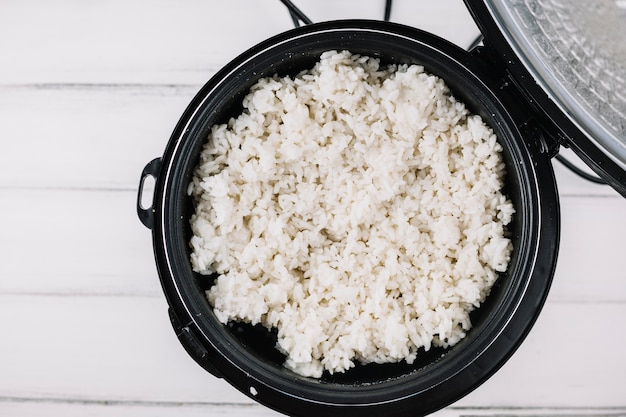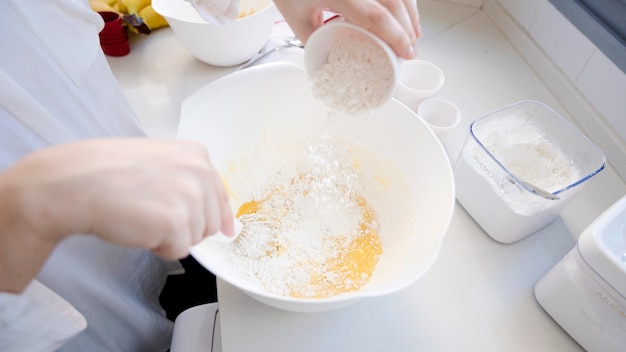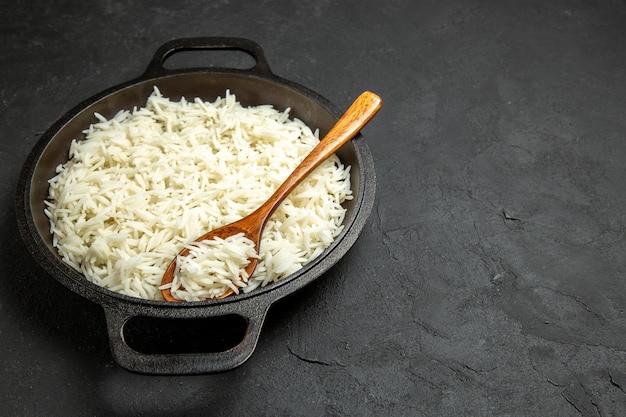Let's face it, cooking rice can be a bit of a gamble. You’re either left with a pot of mushy, clumpy disaster or dry, hard grains. I've been there, and it wasn't pretty. But then, I discovered the miracle of rice cookers. It's like they whispered, "Relax, we got this," and I haven't looked back. With just a few simple steps and minimal effort, you can have perfect rice, every single time. So, ditch the stress and join me on this journey to rice-cooking nirvana.
(Part 1) The Perfect Rice Cooker: Your New Kitchen Best Friend

choosing the right rice cooker is like finding the perfect pair of jeans - it needs to fit your lifestyle and be comfortable to use. It's an investment in effortless cooking, so don't rush the decision. Take your time to find the one that truly sings to your culinary soul.
1.1. Sizing Up Your Needs
First things first: consider your rice-cooking needs. Are you feeding a family of four or just whipping up a solo dinner? Rice cookers come in various sizes, typically from 1 cup to 10 cups, so choose one that matches your portions. Don't go overboard with a giant cooker if you're a solo diner; you'll end up with leftover rice more often than you'd like.
1.2. Beyond Basic Rice: Exploring Features
Rice cookers are no longer just for, well, rice. Some models are multi-functional powerhouses, capable of steaming vegetables, making porridge, or even baking cakes. Personally, I can't live without the "keep warm" function. It's a lifesaver for those times you're running late or just want to keep your rice warm and fluffy for hours.
You might also find options like fuzzy logic technology (which adjusts cooking time based on the type of rice and amount of water), pre-programmed settings for specific rice varieties, and even a built-in timer so you can wake up to perfectly cooked rice. It's all about figuring out what features are essential to your kitchen routine.
1.3. budget-friendly to High-End: Finding Your Sweet Spot
Rice cookers are available at various price points. You can find basic models for under ??30, while some high-end options can cost upwards of ??100. Remember, you don't need to break the bank to get a reliable rice cooker. Many affordable models perform admirably. It's all about striking that balance between features and budget, finding the rice cooker that fits your needs without overspending.
(Part 2) The First Rice Cooker Dance: Setting the Stage

Okay, you’ve got your shiny new rice cooker, and it's time to unleash its culinary magic! It's not rocket science, but there are a few simple steps to ensure you get that perfect fluffy rice.
2.1. A Clean Slate: Preparing the Inner Pot
Before you even think about rice, give your rice cooker's inner pot a quick wash with warm soapy water. Imagine it as your rice cooker's first spa day, a fresh start before the culinary magic begins. Let it air dry completely before you start.
2.2. The Instruction Manual: Your Rice Cooker’s Guidebook
Don't be tempted to skip the instruction manual. It's like your rice cooker's personal guidebook, packed with essential information specific to your model. It'll explain the different settings, functions, and even give you tips for different types of rice.
2.3. Measure It Out: The Key to Perfect Rice
Now, for the rice! You'll need to use the measuring cup that came with your rice cooker. It’s designed to work perfectly with your model, ensuring the right amount of rice for optimal cooking. For every cup of rice, you'll generally need about 1 and a half cups of water. However, each model might have specific water level markings or instructions, so refer to your manual.
2.4. A Rinse for a Smoother Ride: Removing Excess Starch
Think of rinsing the rice as a quick shower before its cooking journey. It helps to remove excess starch, which can make the rice sticky and clumpy. I usually rinse my rice in a sieve under running water for about a minute or two, until the water runs clear.
2.5. Cooking Time: Press Play and Relax
Now, the grand finale! Add your rinsed rice and water to the inner pot, close the lid, and select the appropriate cooking setting. Most rice cookers have a basic "white rice" setting, but some offer options for different types of rice, such as brown rice or jasmine rice. Just follow your rice cooker's instructions. Finally, press "start" and let the rice cooker work its magic.
(Part 3) Decoding the Rice Cooker Signals: Understanding the Process

The rice cooker might seem like a silent ninja, but it has its own ways of communicating. Don't worry, it's a pretty simple language.
3.1. The Cooking Phase: Let the Rice Transform
You'll usually hear a clicking sound or see a light come on, indicating that your rice cooker is busy transforming your raw rice into a fluffy masterpiece. This is the cooking phase. Resist the urge to lift the lid during this time. It's like peeking into a magician's bag mid-trick; you could disrupt the process and end up with undercooked rice. Patience, young grasshopper!
3.2. The "Keep Warm" Mode: A Culinary Comfort Zone
Once the rice is cooked to perfection, your trusty rice cooker will automatically switch to "keep warm" mode, keeping it at a perfect temperature for hours. Imagine it as a warm hug for your rice, ensuring it remains fluffy and delicious until you're ready to enjoy it. Some models even have a timer feature, allowing you to set a delayed start, so you can wake up to a perfectly cooked breakfast or have dinner ready when you walk in the door.
3.3. The "Done" Signal: The Moment of Truth
You'll know the rice is ready when you hear a beep, see a light flash, or both. This is the moment of truth, the culinary climax! Open the lid, take a deep breath of that amazing aroma, and marvel at your perfectly cooked rice. It's a feeling of pure rice-cooking satisfaction.
(Part 4) Troubleshooting Rice Cooker Hiccups: Fixing Those Little Problems
Rice cookers are pretty reliable, but even the best of them can occasionally have a hiccup or two. Don't worry; there's usually a simple solution to any rice-cooking conundrums.
4.1. sticky rice: A Sign of Too Much Starch
If your rice is too sticky, it could mean you didn't rinse it properly, leaving too much starch behind. Give it a thorough rinse next time, ensuring the water runs clear. Another possibility is using too much water. Double-check the water level and adjust it for a fluffier result.
4.2. Dry Rice: A Thirsty Grain
Dry rice is usually a sign of not enough water. Next time, add a bit more water and see if that solves the problem. Remember, it might take a few tries with a new rice cooker to find the perfect water-to-rice ratio. Experimentation is key to mastering your culinary skills!
4.3. Hard Rice: A Need for More Time
Hard rice suggests it hasn't cooked long enough. Try increasing the cooking time by a few minutes for your next rice adventure. Adding a touch of butter or oil during cooking can also help to make the rice more moist.
(Part 5) Beyond Basic White Rice: Exploring Rice Cooker Possibilities
Now that you've conquered the art of basic white rice, it's time to unleash your inner culinary adventurer! Many rice cookers have settings for different types of rice, and some are even multi-functional, expanding your culinary horizons.
5.1. The World of Brown Rice: A Healthier Choice
Brown rice is a nutritional powerhouse, packed with fiber and nutrients. However, it takes longer to cook than white rice, so your rice cooker will have a dedicated "brown rice" setting. Just select it, add the rice and water, and let the rice cooker work its magic. You'll be rewarded with perfectly cooked brown rice without the hassle of traditional cooking methods.
5.2. A Rice Safari: Discovering Flavorful Varieties
Once you've mastered brown rice, why not explore the vast world of rice varieties? Jasmine rice is known for its fragrant aroma and fluffy texture, popular in Thai cuisine. basmati rice is another long-grain variety with a delicate aroma and fluffy texture, perfect for Indian dishes. Experiment with different varieties, discovering new flavors and textures. You can even use your rice cooker to cook sushi rice, porridge, or even sticky rice for Asian desserts.
5.3. Steaming Perfection: Vegetables and Beyond
Some rice cookers come with a handy steaming basket, allowing you to cook vegetables while your rice cooks, making meal prep a breeze. Imagine a single pot creating both fluffy rice and perfectly steamed vegetables, all in one go! I love steaming broccoli, carrots, and other veggies with my rice, making it a quick, easy, and healthy meal.
(Part 6) rice cooker tips and Tricks: Elevating Your Culinary Game
You've got the basics, but here are a few extra tips and tricks to help you become a true rice-cooking master.
6.1. Pre-Soaking for Superior Fluffiness
For extra fluffy rice, try soaking the rice in water for 30 minutes before cooking. It helps soften the grains and allows them to absorb water more evenly, resulting in a lighter, fluffier texture. Just make sure to drain the rice thoroughly before cooking.
6.2. The Art of Fluff: A Quick Steam Boost
For even fluffier rice, try this trick: After the rice is cooked, let it sit in the rice cooker for a few minutes with the lid closed. The steam circulates, making the rice lighter and airier. It's like a little rice spa treatment.
6.3. Don't Overcrowd the Pot: Giving Rice Room to Breathe
Avoid overfilling the inner pot, leaving some space at the top for the rice to expand as it cooks. Overcrowding the pot can prevent the rice from cooking evenly and might even lead to a messy overflow.
6.4. Flavor Adventures: Adding Your Personal Touch
Don't be afraid to experiment with flavors! You can add herbs, spices, or even a little butter or oil to your rice while it's cooking. For a touch of umami, try a tablespoon of soy sauce or fish sauce. You can even create a flavorful rice dish by adding chopped vegetables, like onions, garlic, or peppers, to the pot during the cooking process. Get creative, experiment with different flavors, and discover your own unique rice combinations.
(Part 7) rice cooker recipes: A Culinary Starting Point
Need some inspiration? Here are a few simple rice cooker recipes to get you started:
7.1. Garlic Herb Rice: Aromatic and Flavorful
Ingredients:
- 1 cup white rice
- 1 1/2 cups water
- 2 cloves garlic, minced
- 1 tablespoon chopped fresh herbs (like parsley, oregano, or thyme)
- Salt and pepper to taste
Instructions:
- Rinse the rice thoroughly.
- Add the rice, water, garlic, herbs, salt, and pepper to the rice cooker.
- Select the "white rice" setting and cook according to your rice cooker's instructions.
- Fluff the rice with a fork before serving.
7.2. Tomato Rice: A Simple and Savory Dish
Ingredients:
- 1 cup white rice
- 1 1/2 cups water
- 1 cup diced tomatoes
- 1/2 teaspoon salt
- 1/4 teaspoon black pepper
- 1/4 teaspoon dried oregano
Instructions:
- Rinse the rice thoroughly.
- Add the rice, water, tomatoes, salt, pepper, and oregano to the rice cooker.
- Select the "white rice" setting and cook according to your rice cooker's instructions.
- Fluff the rice with a fork and serve warm.
(Part 8) FAQs: Your Rice Cooker Questions Answered
Rice cookers are pretty user-friendly, but questions inevitably arise. Here are some answers to common rice cooker queries.
8.1. Pasta in a Rice Cooker: A Culinary Experiment
Yes, you can cook pasta in a rice cooker, but it's best to use quick-cooking pasta like angel hair or spaghetti. Add the pasta to the rice cooker with enough water to cover it. Then, cook according to the pasta's package instructions. However, be sure to check the pasta for doneness after about 10 minutes. Some rice cookers might not have the same level of heat as a stovetop. You can also use the steaming basket for cooking pasta in your rice cooker. Place the pasta in the basket, add enough water to the pot to reach the bottom of the basket, and cook as directed on the pasta package.
8.2. Quinoa in a Rice Cooker: Expanding Your Culinary Repertoire
Yes, you can cook quinoa in a rice cooker, using the same water-to-quinoa ratio as you would for rice. Rinse the quinoa before adding it to the rice cooker. Most rice cookers have a "quinoa" setting, but if not, you can use the "brown rice" setting. Check the quinoa for doneness after about 20 minutes. If it's still hard, cook it for a few more minutes.
8.3. Soup in a Rice Cooker: One-Pot Wonders
Yes, you can cook soup in a rice cooker. Add all of the ingredients to the rice cooker and select the "soup" or "stew" setting. If your rice cooker doesn't have these settings, you can use the "slow cook" setting. Just remember to stir the soup occasionally to prevent it from sticking to the bottom of the pot.
8.4. Maintaining Your Rice Cooker: Keeping It Clean and Happy
Clean your rice cooker after each use. Wash the inner pot with warm soapy water and let it air dry. Wipe down the outside of the rice cooker with a damp cloth. Occasionally clean the lid and steam vent to prevent buildup of food particles. A clean rice cooker is a happy rice cooker!
8.5. The Benefits of Rice Cooker Magic: Efficiency and Ease
Using a rice cooker comes with many benefits, making it a valuable addition to any kitchen:
- Effortless Cooking: Just add the rice and water, press a button, and relax. No more standing over the stove, constantly checking the rice.
- Perfect Rice Every Time: Say goodbye to overcooked or undercooked rice disasters. Rice cookers cook rice evenly and consistently.
- Safety First: Rice cookers are designed with safety features that prevent overheating or burning the rice.
- energy efficiency: Rice cookers use less energy than a stovetop, saving you money on your energy bill.
- Versatility: You can cook various types of rice, as well as other dishes like soups, stews, and even desserts, in your rice cooker.
There you have it: a comprehensive guide to rice cooker mastery. Now, go forth and embrace the world of rice cookers, creating delicious, perfect rice with minimal effort. Happy cooking!
Everyone is watching

Prime Rib Roast Cooking Time Chart: Per Pound Guide
Cooking TipsPrime rib roast. Just the name conjures images of lavish dinners, crackling fires, and hearty laughter. It’s ...

How Long to Bake Potatoes in the Oven (Perfect Every Time)
Cooking TipsBaked potatoes are a staple in my kitchen. They're incredibly versatile, delicious, and surprisingly easy to m...

Perfect Rice Every Time: The Ultimate Guide to Cooking Rice
Cooking TipsAs a self-proclaimed foodie, I've always been a bit obsessed with rice. It's the foundation of countless cuisi...

The Ultimate Guide to Cooking Asparagus: Tips, Techniques, and Recipes
Cooking TipsAsparagus. The mere mention of this spring delicacy conjures up images of vibrant green spears, crisp and burs...

Ultimate Guide to Cooking the Perfect Thanksgiving Turkey
Cooking TipsThanksgiving. Just the word conjures up images of overflowing tables laden with delicious food, the scent of r...
